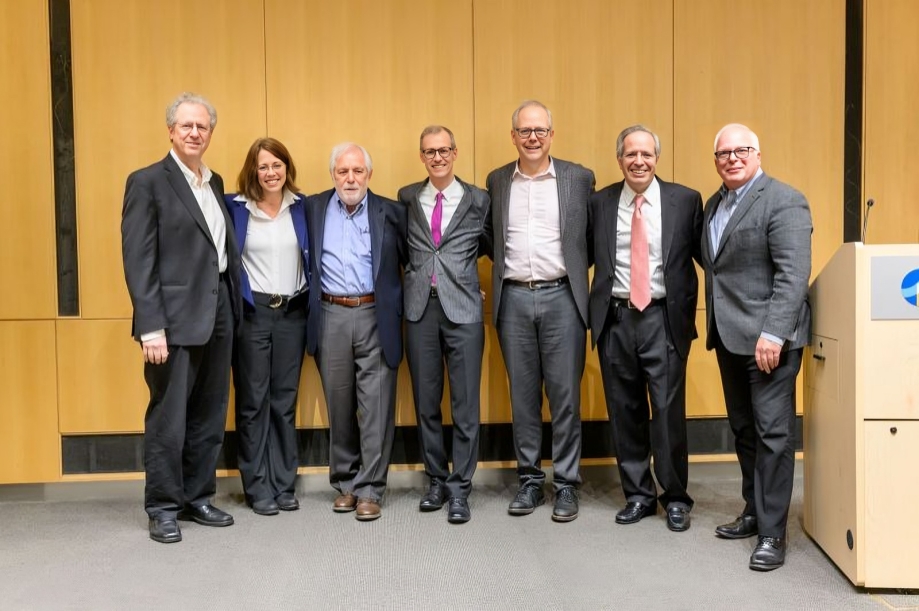Dana-Farber Cancer Institute shared on LinkedIn:
”The Jimmy Fund Auditorium was filling fast last month, just before 3 p.m. As people walked in, their eyes flashed with recognition of dear colleagues, some not seen in a long time. The room buzzed with chatter and laughter.
The occasion was the First Annual Jerry Ritz Symposium on Cellular Therapies. The endowed lecture had been dreamed up by Robert J. Soiffer, chief of the Division of Hematologic Malignancies, and Catherine Wu, chief of the Division of Stem Cell Transplantation and Cellular Therapies and made possible by many in attendance. The idea was to honor Jerome Ritz, in perpetuity, for his contributions to the field, which are many.
Soiffer, who met Ritz 40 years ago when he joined Ritz’s lab at Dana-Farber as a fellow, acted as emcee and listed those contributions: the first monoclonal antibodies to acute lymphoblastic leukemia, T cell depletion to prevent graft vs host disease, the biology of low-dose interleukin-2, NK cell biology, the roles of B cells and T regulatory cells in chronic graft vs host disease, the formation of the Connell and O’Reilly Families Cell Manipulation Core Facility (of which Ritz is currently Executive Director), and the Ted and Eileen Pasquarello Tissue Bank.
Wu sent a warm congratulatory video message from Stockholm, Sweden, where she was receiving the Sjöberg Prize.
Ritz’s scientific contributions were central to the talks, which were presented by leaders from around the world in stem cell transplantation and cell therapy, four of whom had trained with Ritz and one a longtime collaborator.
- Michael A Caligiuri, City of Hope, presented ‘NK Cells: Why your first cold sore doesn’t kill you.’
- Denis-Claude Roy, Hopital Maisonneuve-Rosemont, presented ‘Allogeneic Cell Graft Manipulations to Tackle Blood Cancers.’
- David Miklos, Stanford University, presented ‘CAR-T and the Virtues of Correlative Science.’
- Stefanie Sarantopoulos, Duke Cancer Institute, presented ‘Targeting Rare Bad B Cells in the Chronic GVHD.’
- Bruce Blazar, University of Minnesota, presented ‘Chimeric Antigen Receptor CD8 Induced Treg Mediate GVL and Suppress GVHD.’
The presentations were about leading-edge science, but the theme that stood out and was evident the moment the room began to fill, was the value Ritz places on relationships.
Miklos, who trained with Ritz in the 1990s as a fellow, recalled that Ritz had counseled him to ‘work smart.’ That meant focusing on the things you need to do and that benefit you. The list is fairly small: family, sleep and exercise, billing and finances, and team building.
After the talks, Soiffer invited Ritz to the stage. Applause erupted in a standing ovation.
Ritz, humbled, spoke briefly: ‘Helping people is the reason I’m here and the reason all of us are here. We are here to help our patients. We’re here to help each other. And we’re here to help the next generation of people to continue the work that we’re doing.”’
Source: Dana-Farber Cancer Institute/LinkedIn
Dana-Farber Cancer Institute, located in Boston, Massachusetts, is a leading institution for cancer treatment and research. It was founded by Sidney Farber on 1947. Currently, the Institute has over 5,000 staff, faculty, and clinicians on board. They manage in excess of 640,000 outpatient visits each year, oversee more than 1,000 hospital discharges annually, and are actively involved in over 1,100 ongoing clinical trials.
As of 2023, Dana-Farber is ranked as the #4 cancer hospital globally. Dana-Farber’s research contributions include the development of Gleevec, a highly successful treatment for chronic myeloid leukemia.
